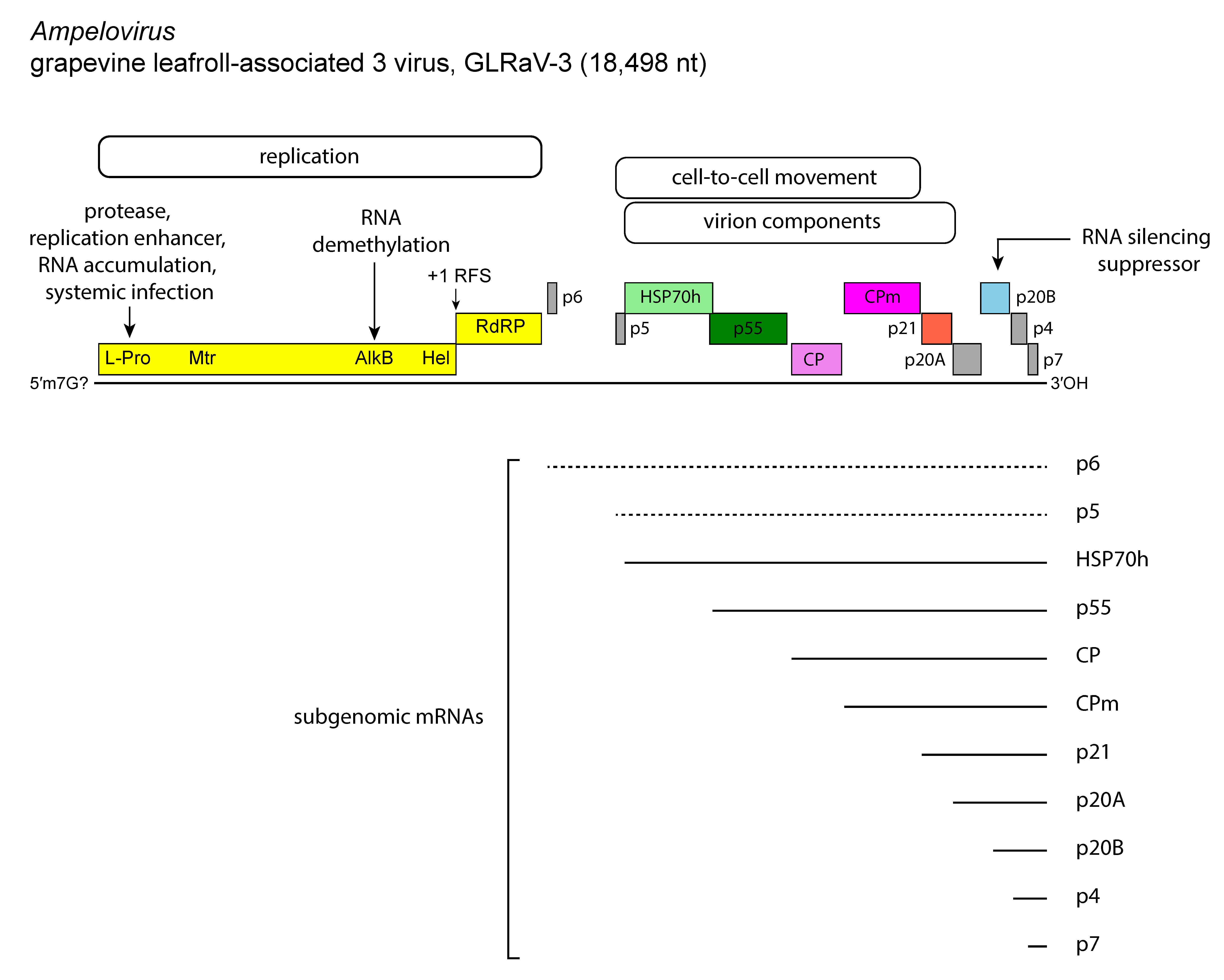Family: Closteroviridae
Genus: Ampelovirus
Distinguishing features
The genus comprises species whose members have virions that are 1,400–2,000 nm long, a monopartite genome of 13.0–18.5 kb, and are transmitted by pseudococcid mealybugs and soft scale insects.
Virion
Morphology
See discussion under family description.
Physicochemical and physical properties
See discussion under family description.
Nucleic acid
Virions contain a single molecule of linear, positive-sense, single-stranded RNA of 13.0 to 18.5 kb. Multiple dsRNA species occur in infected tissues, the largest of which is usually the replicative form of the entire genome. Smaller dsRNAs are thought to be replicative forms of subgenomic RNAs.
Proteins
Structural proteins consist of a major coat protein (CP) and a minor CP (CPm), with masses ranging from 28 to 36 kDa (CP) and 50 to 56 kDa (CPm), according to virus, although subgroup II ampeloviruses apparently lack a CPm.
Lipids
None reported.
Carbohydrates
None reported.
Genome organization and replication
Members of the genus Ampelovirus show a wide variation in genome length and organization. At one extreme, there are grapevine leafroll-associated virus 1 (GLRaV-1) and grapevine leafroll-associated virus 3 (GLRaV-3), which have the largest genomes (18.5 kb). The genome of GLRaV-3 has 12 ORFs, encoding the replication related proteins (ORFs 1a and 1b), two small hydrophobic proteins (6 kDa), HSP70h, the ~60 kDa protein, coat protein (CP), minor coat protein (CPm) and the 21, 20A, 20B, 4 and 7 kDa proteins (Figure 1. Ampelovirus) (Maree et al., 2013). The 5´-UTR and 3´-UTR are 737 and 277 nt, respectively, in the exemplar isolate (Maree et al., 2013). The genome of GLRaV-1 differs from that of all other members of the genus in encoding two copies of CPm. At the other extreme, there is a group of viruses infecting grapevine [e.g, grapevine leafroll-associated virus 4 (GLRaV-4) and related strains] and pineapple [e.g. pineapple mealybug wilt-associated virus 1 (PMWaV-1) and pineapple mealybug wilt-associated virus 3 (PMWaV-3)] with simpler genomes made up of seven ORFs and lacking the CPm. PMWaV-1 has a genome of 13,071 nt, beginning with a 535 nt UTR at the 5′-end followed by the ORFs expressing the replication related proteins, a 6 kDa hydrophobic protein, the HSP70h, the ~60 kDa protein, the CP and a 24 kDa protein. A 3′-UTR of 132 nt terminates the genome. Replication occurs in the cytoplasm, likely in association with membranous vesicles, derived either from the endoplasmic reticulum or from peripheral vesiculation and disruption of mitochondria, as shown for GLRaV-1 and GLRaV-3. Structural and non-structural proteins are similar in type and function to those reported for the genus Closterovirus.
 |
|
Figure 1. Ampelovirus. Genome organization of grapevine leafroll-associated virus 3 (GLRaV-3), a member of the type species of the genus Ampelovirus, showing the relative position of the open reading frames and their expression products: UTR, untranslated region; L-Pro, leader papain-like protease; Mtr, methyltransferase; AlkB, alpha-ketoglutarate-dependent hydroxylase domain; Hel, helicase; RdRP, RNA-directed RNA polymerase; HSP70h, heat shock protein 70 homolog; ~60 kDa protein; CP, coat protein; CPm, minor coat protein. The predicted sub-genomic RNAs (sgRNAs) are indicated below the genome map. Putative sgRNAs are indicated by dashed lines. |
Biology
Members of the majority of extant ampelovirus species have been recorded from woody hosts (grapevine, plum, cherry, pistachio, blackberry and pineapple), on which, according to the host, they induce mottling, rolling yellowing and reddening of the leaves (grapevine), stem pitting (plum), wilting or symptomless infections (pineapple). Natural vectors are mealybugs and soft scale insects, which transmit in a semipersistent modality. The range of vectors varies for individual viruses from rather wide to restricted. For instance, GLRaV-1 is transmitted by species of several genera of pseudococcid mealybugs (Heliococcus, Phenacoccus, Pseudococcus) and soft scale insects (Pulvinaria, Neopulvinaria, Parthenolecanium); GLRaV-3 by pseudococcid mealybugs (Planococcus, Pseudococcus, Heliococcus, Phenacoccus) and soft scale insects (Pulvinaria, Neopulvinaria, Parthenolecnium, Coccus, Saissetia, Parasaissetia, Ceroplastes), whereas GLRaV-4 is transmitted by Pseudoccocus, Planococcus and Ceroplastes spp. Vectors of pineapple ampeloviruses are two species of the genus Dysmicoccus, and little cherry virus 2 (LChV-2) is transmitted by Phenacoccus aceris. None of the viruses is transmitted through seed or mechanically. All persist in plant parts used for propagation and are disseminated with them over long distances, resulting in a very wide geographic distribution.
Antigenicity
Polyclonal antisera and monoclonal antibodies have been raised to most of the members of the genus. A recombinant single-chain variable fragment antibody was synthesized to GLRaV-3. GLRaV-1 and GLRaV-3 are distantly serologically related based on cross-reactivity to a monoclonal antibody to GLRaV-1. Similarly, GLRaV-1 and grapevine leafroll-associated virus 13 are serologically related. GLRaV-4 and related strains, i.e., GLRaV-4 strain 5, GLRaV-4 strain 6, GLRaV-4 strain 9, GLRaV-4 strain Car, GLRaV-4 strain De, GLRaV-4 strain Pr, and GLRaV-4 stain Ob, show serological interrelations when tested with polyclonal antisera or monoclonal antibodies. The three pineapple mealybug wilt-associated viruses are serologically unrelated to one another.
Species demarcation criteria
The criteria demarcating species in the genus are:
- Particle size.
- Size of CP, as determined by deduced amino acid sequence data.
- Serological specificity using discriminatory monoclonal or polyclonal antibodies.
- Genome structure and organization (number, relative location and size of the ORFs).
- Amino acid sequence of relevant gene products (RdRP, CP, HSP70h) differing by more than 25%.
- Vector species and specificity.
- Magnitude and specificity of natural host range.
- Cytopathological features (i.e., aspect of inclusion bodies and origin of cytoplasmic vesicles).
Related, unclassified viruses
|
Virus name |
Accession number |
Virus abbreviation |
|
fig leaf mottle-associated virus 2 |
FLMaV2 |
|
|
pistachio ampelovirus A |
PAVA |
|
|
sugarcane mild mosaic virus |
SCMMV |
Virus names and virus abbreviations are not official ICTV designations.

